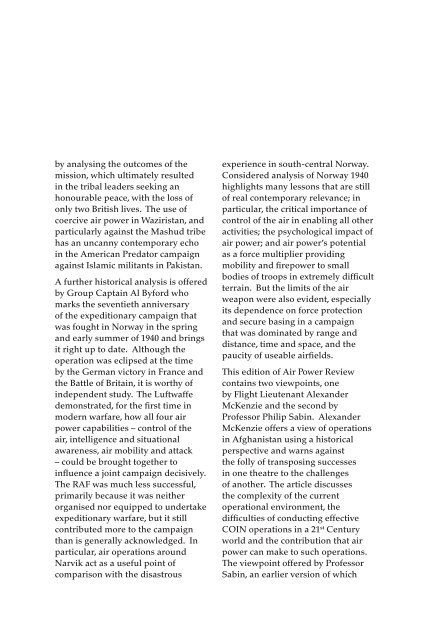The Qur'an and War - Air Power Studies
The Qur'an and War - Air Power Studies
The Qur'an and War - Air Power Studies
Create successful ePaper yourself
Turn your PDF publications into a flip-book with our unique Google optimized e-Paper software.
y analysing the outcomes of the<br />
mission, which ultimately resulted<br />
in the tribal leaders seeking an<br />
honourable peace, with the loss of<br />
only two British lives. <strong>The</strong> use of<br />
coercive air power in Waziristan, <strong>and</strong><br />
particularly against the Mashud tribe<br />
has an uncanny contemporary echo<br />
in the American Predator campaign<br />
against Islamic militants in Pakistan.<br />
A further historical analysis is offered<br />
by Group Captain Al Byford who<br />
marks the seventieth anniversary<br />
of the expeditionary campaign that<br />
was fought in Norway in the spring<br />
<strong>and</strong> early summer of 1940 <strong>and</strong> brings<br />
it right up to date. Although the<br />
operation was eclipsed at the time<br />
by the German victory in France <strong>and</strong><br />
the Battle of Britain, it is worthy of<br />
independent study. <strong>The</strong> Luftwaffe<br />
demonstrated, for the first time in<br />
modern warfare, how all four air<br />
power capabilities – control of the<br />
air, intelligence <strong>and</strong> situational<br />
awareness, air mobility <strong>and</strong> attack<br />
– could be brought together to<br />
influence a joint campaign decisively.<br />
<strong>The</strong> RAF was much less successful,<br />
primarily because it was neither<br />
organised nor equipped to undertake<br />
expeditionary warfare, but it still<br />
contributed more to the campaign<br />
than is generally acknowledged. In<br />
particular, air operations around<br />
Narvik act as a useful point of<br />
comparison with the disastrous<br />
experience in south-central Norway.<br />
Considered analysis of Norway 1940<br />
highlights many lessons that are still<br />
of real contemporary relevance; in<br />
particular, the critical importance of<br />
control of the air in enabling all other<br />
activities; the psychological impact of<br />
air power; <strong>and</strong> air power’s potential<br />
as a force multiplier providing<br />
mobility <strong>and</strong> firepower to small<br />
bodies of troops in extremely difficult<br />
terrain. But the limits of the air<br />
weapon were also evident, especially<br />
its dependence on force protection<br />
<strong>and</strong> secure basing in a campaign<br />
that was dominated by range <strong>and</strong><br />
distance, time <strong>and</strong> space, <strong>and</strong> the<br />
paucity of useable airfields.<br />
This edition of <strong>Air</strong> <strong>Power</strong> Review<br />
contains two viewpoints, one<br />
by Flight Lieutenant Alex<strong>and</strong>er<br />
McKenzie <strong>and</strong> the second by<br />
Professor Philip Sabin. Alex<strong>and</strong>er<br />
McKenzie offers a view of operations<br />
in Afghanistan using a historical<br />
perspective <strong>and</strong> warns against<br />
the folly of transposing successes<br />
in one theatre to the challenges<br />
of another. <strong>The</strong> article discusses<br />
the complexity of the current<br />
operational environment, the<br />
difficulties of conducting effective<br />
COIN operations in a 21 st Century<br />
world <strong>and</strong> the contribution that air<br />
power can make to such operations.<br />
<strong>The</strong> viewpoint offered by Professor<br />
Sabin, an earlier version of which
















